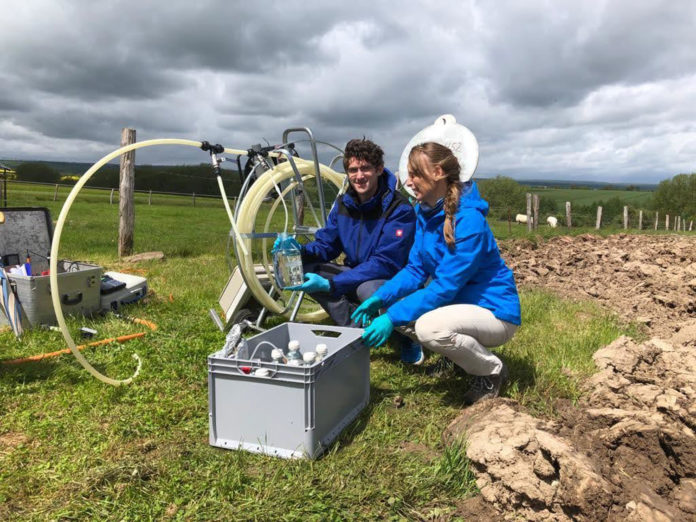The terrestrial subsurface contains nearly all of Earth’s freshwater reserves and harbors most of our planet’s total prokaryotic biomass. Although genetic surveys suggest these organisms rely on in situ carbon fixation rather than the photosynthetically derived organic carbon transported from surface environments, direct measurements of carbon fixation in the subsurface are absent.
Using a unique, ultra-sensitive measurement method using radioactive carbon, the Friedrich Schiller University Jena and the German Centre for Integrative Biodiversity Research (iDiv) demonstrated that these biotic communities in absolute darkness are not sunlight-dependent. Instead, they rely on rock oxidation or compounds transported into the deep to obtain energy.
Their study suggests that the microorganisms in aquifers below the Earth’s surface produce similar amounts of biomass as in some marine waters.
Scientists measured microbial microorganism carbon fixation in a subsurface aquifer, 5 to 90 meters below ground.
The first author of the study Dr. Will Overholt, Postdoctoral Researcher at Friedrich Schiller University Jena, said, “The rates we measured were much higher than we anticipated. They equal carbon fixation rates measured in nutrient-poor marine surface waters and are up to six-fold greater than those observed in the lower zones of the sunlit open ocean, where there is just enough light for photosynthesis.”
Scientists conservatively calculated the global primary production in carbonate groundwater to be 110 million metric tonnes of carbon per year based on the measured carbon fixation rates. 260 million metric tonnes of carbon would be produced annually by the net primary productivity of the planet’s groundwater reservoirs, equivalent to 0.5% of marine systems and 0.25 of projections for net direct output worldwide.
Senior author Prof Kirsten Küsel from the Friedrich Schiller University Jena and iDiv said, “This may sound small, but these measurements represent only our first estimate of the true global value. Since very little energy is available in these nutrient-poor and permanently dark habitats, even a small percentage of the global primary production is a surprise.”
Scientists also identified the microorganisms responsible for fixing carbon and generating new biomass within the aquifer. A highly prevalent microbe from an uncharacterized order of Nitrospiria that is not closely linked to previously described bacteria has been identified using metagenomic analysis.
Overholt said, “As food, these organisms are thought to form the basis of life for the entire groundwater ecosystem with all of its thousands of microbial species, similar to the role algae play in the oceans or plants on land.”
Prof Susan Trumbore from the Max Planck Institute for Biogeochemistry in Jena said, “Measuring carbon fixation can be done with radioactively labeled carbon dioxide. In carbonate rock environments, there is abundant dissolved CO2, making it difficult to observe carbon fixation rates directly. The team, therefore, used a special method to trace a small amount of labeled CO2 using highly sensitive accelerator mass spectrometry. It is exciting to see what new insights these methods can lead to.”
Kirsten Küsel said, “Our findings offer new insights into how these subsurface ecosystems function, giving clues on how to monitor or remediate groundwater sources.”
Journal Reference:
- Overholt, W.A., Trumbore, S., Xu, X. et al. Carbon fixation rates in groundwater similar to those in oligotrophic marine systems. Nat. Geosci. (2022). DOI: 10.1038/s41561-022-00968-5
